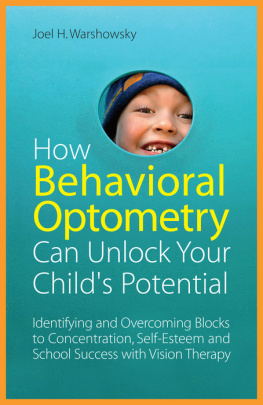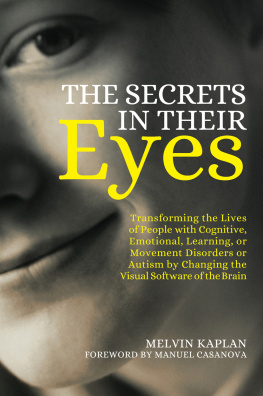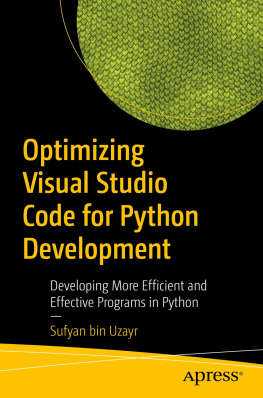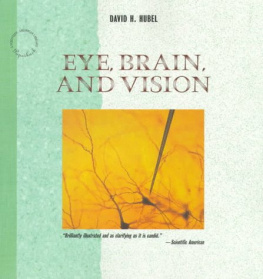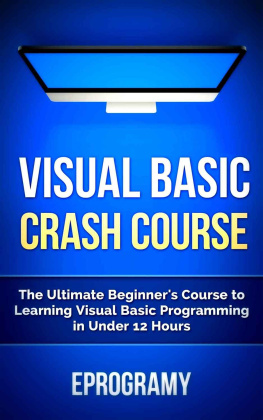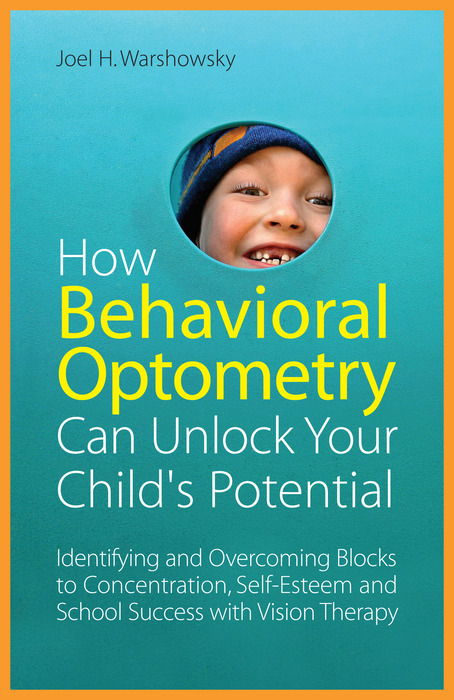Identifying and Overcoming Blocks to Concentration, Self-Esteem and School Success with Vision Therapy
Joel H. Warshowsky
Copyright Joel H. Warshowsky 2012
All rights reserved. No part of this publication may be reproduced in any material form (including photocopying or storing it in any medium by electronic means and whether or not transiently or incidentally to some other use of this publication) without the written permission of the copyright owner except in accordance with the provisions of the Copyright, Designs and Patents Act 1988 or under the terms of a licence issued by the Copyright Licensing Agency Ltd, Saffron House, 610 Kirby Street, London EC1N 8TS. Applications for the copyright owners written permission to reproduce any part of this publication should be addressed to the publisher.
Warning: The doing of an unauthorised act in relation to a copyright work may result in both a civil claim for damages and criminal prosecution.
Warshowsky, Joel H.
vision therapy / Joel H. Warshowsky.
p. cm.
Includes bibliographical references and index.
ISBN 978-1-84905-881-0 (alk. paper)
1. Behavioral optometry. 2. Visual training. 3. Vision disorders in
children. I. Title.
Acknowledgments
As I look into my past, I find myself moving through the corridors of my mind as if I were opening up this old family chest high up in the attic. Upon opening the chest, I find an old newspaper clipping yellowed and torn with age, yet the writing remains as it had originally been. The words are as clear as they were when they were freshly typed. I, like so many of us, have struggled to be where I am today. But, just as clear as those typed letters and words on that dingy newspaper clipping, I clearly know those individuals who stood by me, letting me know that I could when many were saying that I could not. This book would not have been written if it were not for these individuals.
Let me begin with those optometrists whom Ive learned so much from either through personal interaction or their written material. They have been a platform upon which Ive been able to stand, helping me to believe in myself so that I would be able to practice my profession in the best way I thought possible: Norman Haffner, A.M. Skeffington, Nathan Flax, Irwin Suchoff, Micky Weinstein, Al Rappaport, Elliot Forest, Dan Wolf, Leonard Werner, Ed Johnston, Marty Birnbaum, Harold Solan, Sid Groffman, Allen Cohen, Arnie Sherman, Jacob Lieberman, Al Sutton, Amiel Francke, Robert A. Kraskin, Larry MacDonald, Bruce Wolff, Dick Appell, Gerry Getman, John Streff, Andrea Thau, Carl Gruning, David Fitzgerald, Jack Richman, Ken Cuiffreda, Paul Harris, Glen Steele, and Rochelle Mozlin. I am able to write this book, and practice my profession because of those practitioners who in the past created and practiced the core philosophy that behavioural optometry now represents. Unlike medicine, our history is young, enabling our present thinking to go back to its core values. Throughout this book I make reference to first and second generation behavioural optometrists in order to show respect to those individuals whose shoulders upon whom we presently stand.
There have been many occupational therapists (OTs) and physical therapists (PTs) who have taught me about body dynamics critically important in the development of vision and visions ability to process information. Then there were those who went further in developing the co-joined therapy concept that exists today: Laurie Kalb, Phyllis Gordon, Sheila Allen, Marie Leo, Sylvia Hershkowitz, Susan Oetting, Carrie Strauch, Celeste Furmansky, Joanne Swenson, Rivka Vann, Maryann Martin, Dorothy Fox, Lorraine Aloysio, and Debbie Fuggini.
To the social workers, psychologists, and psychiatrists who taught me the distinct relation between vision and ones development of self, I will be forever grateful. Then there were those who taught me that understanding my own sense of self was critically essential to understanding my patient: Maureen OConnor, Louis Schneider, Florence Springer, Michael Singer, and Michael Leiman.
To all the interns and residents whom Ive had the pleasure to work with all of these years, youve taught me how to learn.
Then there are people throughout my life and career who stood by me with a clear sense of purpose, desire, and belief that their support for me would always be there. Bruchie Langsam always made this clear.
I wish to gratefully acknowledge the contribution of Dr. Charles Koch, retired educator, for helping to make my words reader friendly.
My practice became the place where most of my clinical triumph evolved. If it were not for my staff, I would not have been able to make the changes in the lives of children in the way that I have. I am especially grateful to those who manage my offices: Annette Scorcia and Irene Vitale.
To my children, Justin and Jaime, who have always been for me a light that shines in so many places, opening my eyes to what is real and to what is truly important. Your strength, trust, and love have often been all that I needed to get through the hard times and have shown me how to enjoy the good times.
And to that one person who lets me know all that is good in me and all that I am capable of becoming: my beautiful, inside and out, wife Nicole. Without her strength of conviction, her ceaseless encouragement, her ability to know what is true from what is not true, and her boundless love, I could not have completed this book. She is the one who brings light to where it may not have been before.
Finally, I am truly grateful to all those people at Jessica Kingsley Publishers, namely Lisa Clark, Lucy Buckroyd, Emily McClave, and Claire Cooper, who have taken on this project as their own.
Preface
In the song Empty Garden (Hey Hey Johnny), Elton John calls out to his friend Johnny to come out and play.
Unlike Elton Johns eulogy to John Lennon, the Johnny Im talking about will be able to come out and play, but maybe not today. You see, Johnny, who just began third grade, is not able to get his homework done in time to play with his friends today.
As we all know, playtime is a special time during which children sense all that life can be. For them its the time to fantasize and to dream the dreams that make them special. Its a time full of all the stuff that makes them children. For all the Johnnies who cant have this special time, there grows a feeling of despair and hopelessness. How very sad for our Johnny, for it is his dreams of today that will shape so many of his tomorrows.

